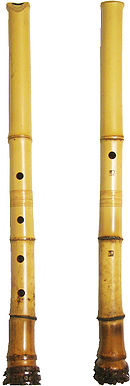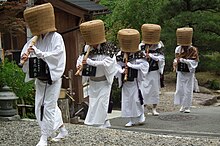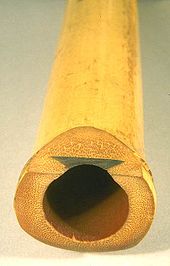Shakuhachi
The shakuhachi ( Japanese 尺八 ) is a Japanese longitudinal bamboo flute that was introduced from China in the 8th century and developed into a meditation instrument for Zen Buddhist monks in the 17th century . Their soft, noisy sound is now considered typical of traditional classical music in Japan. In addition, the shakuhachi is also used in modern western classical music and popular music.
origin
The shakuhachi comes from the Chinese xiao and came to Japan in the early 8th century with the Chinese court music gagaku . There it was initially used in the honkyoku tradition that was passed down orally in the local gagaku ensembles, but where it quickly faded into the background due to its relatively low volume and finally disappeared in the 11th century.
In the Edo period (1603–1868) the shakuhachi reappeared and became an instrument of the Zen Buddhist Fuke-shū , a sect of wandering mendicants who were formerly samurai , and underwent a major change in its use: Wandering monks, the shakuhachi was no longer a musical instrument ( gakki ), but became a religious tool ( hōki ) and formed the focus of meditation exercises. The use of the flute was strictly limited: it was not allowed to be played in concerts, and an outsider was not allowed to hear it. In addition, it was not allowed to play with other instruments. Only their use as a “spiritual tool” was permitted, because only through the play of the shakuhachi was it possible for the members of the sect to attain true enlightenment. The pieces composed by the Fuke monks ( komusō ) are summarized under the term honkyoku and form the most revered shakuhachi musical tradition to this day .
In the course of the Meiji Restoration in 1871, the Fuke sect was banned because of its connections to the Tokugawa government - through its use as spies - and thus also the playing of the shakuhachi for religious purposes. But since the teachers of the instrument did not want to and could not forego their livelihood, its secularization was promoted. As early as the Edo period , the shakuhachi in the Sankyoku ensemble, together with Koto and Shamisen, found its way into courtly musical culture.
The shakuhachi style of playing of the 20th century is based on three different teaching traditions:
- the Kinko school , which mainly teaches traditional compositions,
- the Tozan School , which shows a greater influence of Western music, and
- the Myōan schools , which continue the tradition of the Fuke sect.
In addition, the shakuhachi is one of the most famous Asian musical instruments and is used in their works by both Asian and Western composers.
The komusō Kurosawa Kinko (1710–1771) selected 36 pieces from the honkyoku repertoire, which were played as the mandatory core of the Kinko school and at the temples in and around Edo . These 36 compositions were divided into 18 actual, "inner pieces", which were only played during meditations and temple rituals, as well as into 18 "outer pieces", the performance of which was less strict. The inner pieces are played rhythmically freely and extremely slowly, they consist of musical sections, the length of which is limited by the breath of the player and which are separated from each other by pauses. Within these segments an introductory tone with soft dynamics, a middle main phase with volume fluctuations ( crescendo-decrescendo ) and a final, softer finish can be distinguished.
Design
The shakuhachi is made from the root end of the Madake bamboo ( Phyllostachys bambusoides ). The length of the standard instrument (tuning in d ') is 54.5 cm or 1 Shaku ( 尺 ) and 8 ( 八 hachi ) Sun ( 寸 ), from which the name is derived. Shakuhachis are made from less than 1.5 (tuning in g ') to greater than 2.4 Shaku length (tuning in a).
The tube is usually slightly bent upwards at the end (there are also straight ends) and drilled conically on the inside (from 2 to approx. 1.5 cm). The internal coating of the tube, which is generally multi-layered, protects the flute from moisture on the one hand and contributes to its special sound on the other. The modern flute can often be divided in the middle, making it easier to transport. In addition, each instrument must have seven nodes, the arrangement of which is prescribed. The blowing lip of the mouthpiece ( 歌 口 utaguchi ) is usually provided with a plastic or metal insert of a characteristic shape (see picture on the right, kinko-utaguchi ) to improve the durability of the shakuhachi . With four finger holes and one thumb hole on the standard instruments, the ambitus is 2½ to 3 octaves . The standard variant is tuned in pentatonic minor , but there are also variants with two additional holes for easier access to chromatic tones. What is remarkable about the playing technique is the characteristic movement of the head: on the one hand, in combination with partial covering of the finger holes, it enables the playing of secondary tones, and on the other hand it plays an important role in the ornamentation in addition to finger articulation .
The blowing edge is formed by a notch on the upper edge of the flute tube. The approach takes place by blowing over this edge. The pitch can be varied with the breath pressure. There is hardly any tongue articulation. From the systematics of the flutes according to the type of sound generation, it belongs to the rim-blown flutes without core gap.
While the shakuhachi traditionally consists of bamboo and is made by hand, there are now also machine-made specimens made of plastic or wood, which are cheaper and do not jump as quickly as those made of bamboo, but by far not in terms of sound and appearance bring up a traditional instrument. The sound of a wooden shakuhachi is warmer than the pearly sound of a bamboo flute.
Style of play
The notation of shakuhachi music is traditionally not used as in Western music, but there are different spellings from different schools in which the pitch is defined by certain Japanese syllables ( kana, katakana ), the pitch lengths, octaves and articulations, if at all, specified by certain line shapes and lengths between the characters as well as additional characters. Rules for interpretation are usually passed on orally and / or through the example of the teacher and by imitating the student.
In the Western pop music one finds the shakuhachi often "in sampled " form, such as at the beginning and at the Bridge of Peter Gabriel's hit Sledgehammer or the song Nobody's Listening by Linkin Park . Also on Roger Waters ' album Amused to Death in the song Watching TV is a shakuhachi to hear.
In Germany, the traditional shakuhachi pieces of honkyoku are taught, while the combination with contemporary music is not particularly common. Well-known teachers in Germany are Renkei Hashimoto (Munich) and Jim Franklin. Shakuhachi are now also built in Germany, with the bamboo often imported from Japan or Italy. The seat of the European Shakuhachi Society (ESS), which also has German members, is located in England .
Others
The fairy tale novel Kaito by Hans Kruppa deals with the connection between shakuhachi and Buddhist tradition , in which a 13-year-old boy, because of his longing and a mysterious message, comes to a famous shakuhachi master and becomes his student.
literature
- Ingrid Fritsch: The Tozan School's solo honkyoku. Music for Shakuhachi between the traditional and the modern of Japan . (Studies on Traditional Music of Japan, Volume 4) 2nd edition. Florian Noetzel, Wilhelmshaven 2005, ISBN 978-3795908447 .
- Andreas Gutzwiller: The shakuhachi of the Kinko school . (Studies on Traditional Music of Japan, Volume 5) 2nd edition. Florian Noetzel, Wilhelmshaven 2005, ISBN 978-3795908454 .
- Andreas Gutzwiller, Gerald Bennet: The world of a single sound: basic structure of the music of the Japanese flute shakuhachi. In: Allan Marett (Ed.): Musica Asiatica. Vol. 6. Cambridge University Press, Cambridge 1991, pp. 36-59.
- Riley Lee: Shakuhachi honkyoku notation: written sources in an oral tradition. In: Allan Marett (Ed.): Musica Asiatica. Vol. 6. Cambridge University Press, Cambridge 1991, pp. 18-35.
- Riley Lee: Y earning For The Bell. A study of transmission in the shakuhachi honkyoku tradition. ( Memento of March 23, 2008 in the Internet Archive ) Thesis, University of Sydney 1992.
- Simura Satosi: Chamber Music for Syakuhati. In: Robert C. Provine, Yosihiko Tokumaru, J. Lawrence Witzleben (Eds.): Garland Encyclopedia of World Music. Volume 7: East Asia: China, Japan, and Korea. Routledge, London 2002, pp. 701-705.
- Norman Allen Stanfield: The “San Koten Honkyoku” of the Kinko-Ryū: A Study of Traditional Solo Music for the Japanese Vertical End-Blown Flute - The Shakuhachi. (Master's thesis) The University of British Columbia, Vancouver 1977.
Web links
- The Japanese bamboo flute Shakuhachi. shakuhachi.ch by Jürg Zurmühle
- Shakuhachi website komuso.ch by Wolfgang Hessler
- Shakuhachi - bamboo flute. japanischemusik.com by Christian Grobmeier
English language pages:
- The International Shakuhachi Society
- Some shakuhachi acoustics - scientific homepage of the University of New South Wales
Individual evidence
- ^ Riley Lee, p. 19.
- ↑ Kurosawa Kinko I. komuso.com.
- ↑ Gutzwiller, Bennet, p. 37 f.
- ↑ Hans Kruppa: Kaito . Goldmann, Munich 1996; New edition Coppenrath 2013.



